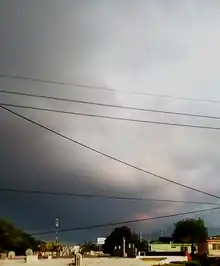| Ancraophobia | |
|---|---|
| Other names | Anemophobia |
| Specialty | Psychology |
Ancraophobia, also known as anemophobia, is an extreme fear of wind or drafts.[1] It is rather uncommon, and can be treated. It has many different effects on the human brain.[2] It can cause panic attacks for those who have the fear, and can make people miss out on regular everyday activities such as going outside.
Origin
Anyone can be born with this disorder or get it later in life. This phobia is most commonly the result of psychological trauma caused by a negative experience with wind in the affected person's past. The experience may be remembered, or it may be "imprinted" on the subconscious mind of the traumatized person.
People who have this phobia tend to be frightened by changes in the weather, such as storms. They are likely to believe that the wind has the potential to kill and destroy. Additionally, they avoid things that remind them of wind, like ocean waves. Ancraophobia is also related to terms like aeroacrophobia, which is the fear of open high places,[3][4] and anemophobia which is the fear of air drafts.[5]

Signs and symptoms
The level of fear as well as other symptoms will vary between individuals. There are four general types of symptoms: psychological, physical, mental and emotional.[6]
Psychological
Psychological symptoms include extreme anxiety when exposed to wind, feelings that the wind may harm or hurt the individual, and a compulsion to avoid encountering wind. The fear of wind is caused by the mind over-estimating the danger caused by wind, believing that wind presents an actual threat, when in reality, it may not.
Physical
Physical symptoms include dry mouth, tremors, tightening in the chest, rapid breathing, sweating of the palms, nausea, irregular heart beat and constant need to pass wind.
Mental
- Obsessive thoughts
- Difficulty thinking about anything other than the fear
- Feelings of unreality or of being detached from oneself
- Fear of losing control
- Fear of fainting
Emotional
- Anticipatory anxiety: persistent worrying about upcoming events that involve air movement.
- Terror: a persistent and overwhelming fear of the same
- Desire to flee: an intense need to leave the situation
Famous Ancraophobiacs
Causes
Ancraophobia is never present at birth. The fear of wind most often arises as a result of a negative experience in the person's past. This experience may or may not be recalled in the conscious mind of the person but this has been imprinted on the subconscious mind. Most often an ancraophobic person experienced a situation where the wind was blowing heavily and they found themselves afraid that the wind might destroy or kill them. This experience becomes linked with the wind, and is known as a "generalized conditioned response". This phobia arises from the combination of external events and an internal predisposition. The external events are things like traumatic events, and the internal predispositions are heredity, or having been transferred from one's blood line. The phobia can often be traced back to negative events that have happened; the most common event is the experience of a traumatic experience at an early age.[7]
Treatment
Scientists have developed medications that can be taken to reduce patients' fears. This medication is known as anti-anxiety medication. However, medications may have side-effects or withdrawal symptoms that can be severe.[8] The most popular form of treatment is visiting a cognitive behavioral therapist, psychologist, psychiatrist, hypnotherapist, or hypnotist. These therapies are also used to help patients forget what they are afraid of. Some basic therapy sessions involve making the patient stand in front of a fan, or making the patient face their fears in a safe environment. With the use of hypnotherapy, the subconscious mind of a person can be reached, potentially eliminating those fears.[9]
See also
- List of phobias
- Lilapsophobia – fear of tornadoes or hurricanes
References
- ↑ John G. Robertson. (2003). An Excess of Phobias and Manias. Senior Scribe Publications. (p. 24).
- ↑ What is Phobia of Wind. Living Healthy. Retrieved February 11, 2014.
- ↑ "Aeroacrophobia - Fear of Open High Places". Archived from the original on 2020-01-11. Retrieved 2014-04-01.
- ↑ "Aeroacrophobia Do you have a fear of open high places?". Retrieved 2014-04-01.
- ↑ "Anemophobia". Retrieved 2014-04-01.
- ↑ What is Phobia of Wind. Living Healthy. Retrieved February 11, 2014.
- ↑ "10 traumatic phobias inspired by nature: Ancraophobia | MNN - Mother Nature Network". www.mnn.com. Archived from the original on 2012-05-15.
- ↑ "Ancraophobia - Wind fear, wind phobia, fear of wind, phobia of wind, Aerophobia, Anemophobia". common-phobias.com. Archived from the original on 2013-01-19.
- ↑ "Anemophobia/Ancraophobia - Fear of Wind/Fear of Drafts/Afraid of the Wind".